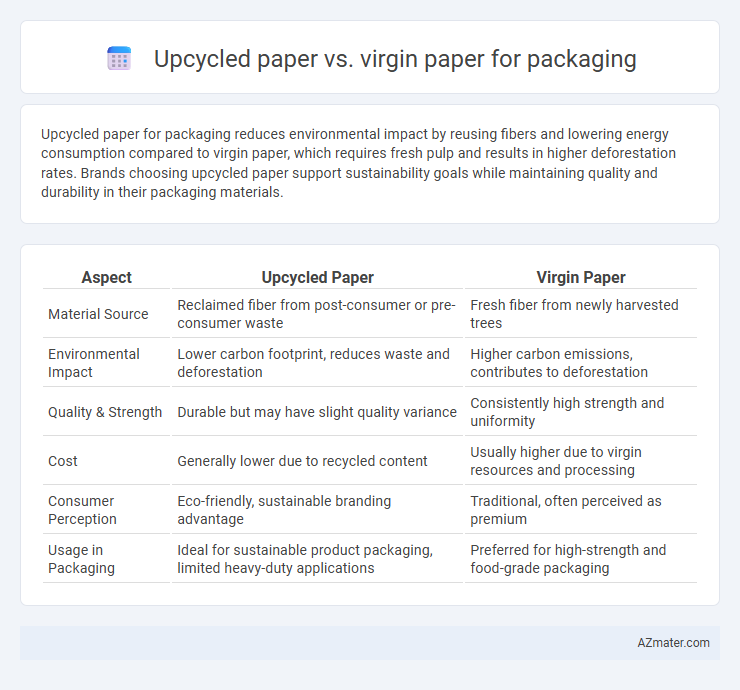Upcycled paper for packaging reduces environmental impact by reusing fibers and lowering energy consumption compared to virgin paper, which requires fresh pulp and results in higher deforestation rates. Brands choosing upcycled paper support sustainability goals while maintaining quality and durability in their packaging materials.
Table of Comparison
| Aspect | Upcycled Paper | Virgin Paper |
|---|---|---|
| Material Source | Reclaimed fiber from post-consumer or pre-consumer waste | Fresh fiber from newly harvested trees |
| Environmental Impact | Lower carbon footprint, reduces waste and deforestation | Higher carbon emissions, contributes to deforestation |
| Quality & Strength | Durable but may have slight quality variance | Consistently high strength and uniformity |
| Cost | Generally lower due to recycled content | Usually higher due to virgin resources and processing |
| Consumer Perception | Eco-friendly, sustainable branding advantage | Traditional, often perceived as premium |
| Usage in Packaging | Ideal for sustainable product packaging, limited heavy-duty applications | Preferred for high-strength and food-grade packaging |
Introduction to Upcycled and Virgin Paper
Upcycled paper is produced by repurposing used paper materials, reducing waste and lowering environmental impact compared to virgin paper, which is made directly from newly harvested trees. Virgin paper offers higher strength and smoothness, making it preferred for premium packaging, while upcycled paper supports eco-friendly branding with its sustainability credentials. Choosing between upcycled and virgin paper for packaging depends on balancing product quality requirements with environmental goals.
Environmental Impact Comparison
Upcycled paper significantly reduces environmental impact by lowering deforestation rates and decreasing water and energy consumption during production compared to virgin paper. Virgin paper packaging involves intensive resource use, contributing to higher greenhouse gas emissions and habitat loss. Selecting upcycled paper for packaging supports waste reduction and promotes a circular economy, making it an eco-friendly alternative.
Resource Consumption and Sustainability
Upcycled paper for packaging significantly reduces resource consumption by utilizing post-consumer waste, lowering the demand for fresh wood fibers and decreasing deforestation rates. Virgin paper production relies heavily on fresh timber, intensive water usage, and high energy inputs, contributing to greater environmental impact and carbon emissions. Upcycled paper enhances sustainability through waste reduction and energy savings, making it a more eco-friendly choice for packaging solutions.
Manufacturing Processes Explained
Upcycled paper for packaging is produced by recycling pre-used paper materials, significantly reducing water and energy consumption compared to virgin paper manufacturing, which involves pulping fresh wood fibers. Virgin paper production requires intensive chemical treatments and mechanical processing to break down raw wood into pulp, contributing to higher carbon emissions and environmental impact. Upcycled paper retains much of its fiber quality through advanced de-inking and cleaning technologies, optimizing resource efficiency and making it a sustainable choice for eco-friendly packaging solutions.
Packaging Quality and Strength
Upcycled paper for packaging offers comparable strength and durability to virgin paper while significantly reducing environmental impact by reusing fiber content. Virgin paper typically provides higher tensile strength and smoother surface quality, making it ideal for premium packaging requiring superior print clarity and structural integrity. Advances in upcycled paper technology have minimized differences in quality, enabling sustainable packaging solutions without compromising performance.
Cost Analysis: Upcycled vs Virgin Paper
Upcycled paper for packaging typically offers cost savings due to lower raw material expenses and reduced energy consumption during production compared to virgin paper. Virgin paper incurs higher costs driven by the need for fresh timber, intensive processing, and greater water and energy usage. Companies prioritizing both sustainability and budget efficiency often find upcycled paper to be the more economical packaging option.
Consumer Perceptions and Market Trends
Consumer perceptions of upcycled paper packaging emphasize environmental responsibility and sustainability, driving increased demand among eco-conscious buyers. Market trends reveal a significant growth in upcycled paper usage as businesses seek to reduce carbon footprints and appeal to green consumers, often highlighting recycled content in branding efforts. In contrast, virgin paper packaging is perceived as higher quality and more durable but faces declining preference due to its environmental impact and resource intensity.
Brand Image and Eco-Friendly Packaging
Upcycled paper enhances brand image by showcasing a commitment to sustainability and reducing environmental impact, appealing to eco-conscious consumers. This eco-friendly packaging option reduces resource consumption and landfill waste compared to virgin paper, which relies on fresh pulp and contributes to deforestation. Brands utilizing upcycled paper often gain competitive advantage through positive public perception and alignment with green marketing values.
Regulatory Standards and Certifications
Upcycled paper for packaging often meets stringent environmental regulatory standards such as the Forest Stewardship Council (FSC) Recycled certification and the Sustainable Forestry Initiative (SFI) standards, ensuring sustainability and reduced environmental impact. Virgin paper packaging aligns with certifications like FSC Controlled Wood and Programme for the Endorsement of Forest Certification (PEFC), which verify responsible sourcing and compliance with timber legality. Both materials must comply with global packaging safety regulations, including FDA guidelines for food contact and EU packaging waste directives, but upcycled paper generally offers enhanced eco-labeling advantages promoting circular economy principles.
Choosing the Right Paper for Your Packaging Needs
Upcycled paper offers eco-friendly packaging with reduced environmental impact by reusing fibers, making it ideal for businesses prioritizing sustainability. Virgin paper provides superior strength and print quality, suitable for premium packaging requiring durability and vibrant graphics. Selecting the right paper depends on balancing environmental goals, product protection needs, and brand presentation to ensure effective and responsible packaging solutions.

Infographic: Upcycled paper vs Virgin paper for Packaging
 azmater.com
azmater.com